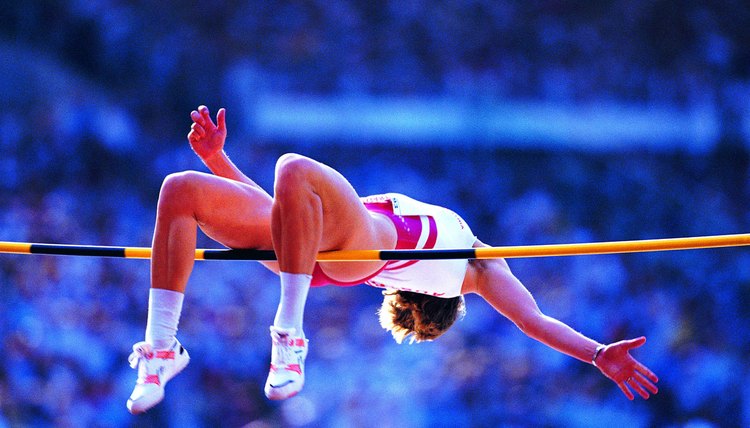Rules of the High Jump

One of several events held in a track and field competition, the high jump must comply with the rules set forth by the sport’s governing body. While most official track and field events abide by the International Association of Athletics Federations rules and regulations, you may find slight rules differences with collegiate and high school competitions. The rules govern everything from apparatus and equipment to footwear and competing.
Requirements for Uprights
IAAF rule 182 states that any style of rigid uprights or standards can be used. The uprights must be between 4 meters and 4.04 meters apart -- about 13 feet 1/8 inch and a maximum of about 13 feet 1/4 inch apart. For high school competitions, the minimum distance can't be less than 12 feet. The crossbar rests on two flat and rectangular supports, each one firmly attached to an upright. Rule 181 requires the supports to be 4 centimeters wide and 6 centimeters long -- about 1.5 inches wide and about 2.3 inches long.
Crossbar Rules
The crossbar, typically made of fiberglass or other suitable material, has three parts -- a circular bar with two end pieces. IAAF rule 181 states that the circular part of the bar must have a diameter of 30 millimeters, which is slightly larger than 1 inch. The two end pieces can be circular or semi-circular but must have a one flat surface, which allows the crossbar to rest on the supports. The crossbar is allowed to sag a maximum of 20 millimeters or about 3/4 inch.
Landing Area Specs
Typically made with cushioning pads or mats and covered by a spike-proof material, the pit or landing area must also comply with the rules. The area must be 6 meters long, 4 meters wide and 0.7 meters high - about 19.50 feet long, 13 feet wide and 2 1/3 feet high. The front corners of the landing pads must have a cutaway to allow the front of the pads to be directly under the crossbar.
Footwear Rules
The rules state that shoes worn by high jumpers may have up to 11 spikes. The protruding portion of the spikes can't be more than 9 millimeters long -- about 1/3 inch. The thickness of the sole can't be more than 13 millimeters -- about 1/2 inch -- and the heel can't be thicker than 19 millimeters -- about 3/4 inch.
Common High Jump Failures
Failures or fouls can happen in a several ways. The more common failures include:
- taking off with two feet
- hitting the bar during the jump, causing it to fall off of its supports
- touching the area beyond the uprights before jumping and clearing the bar
- deliberately steadying the bar during the jump or replacing it after you jump
- and allowing the allotted amount of time for a trial to elapse without jumping.
